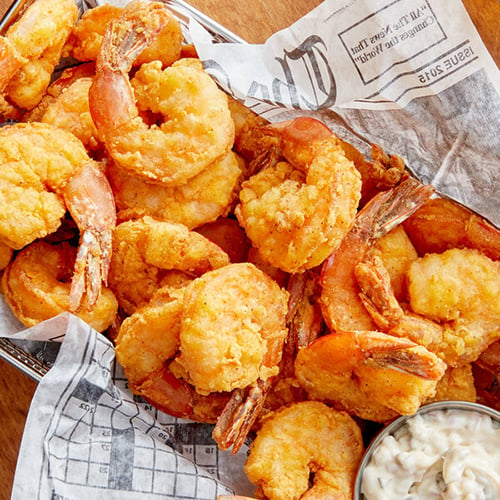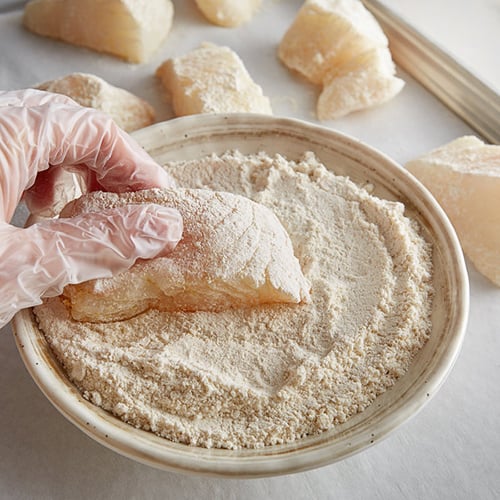Thanks to its neutral flavor, affordable price, and high smoke point, canola oil is the most popular oil for frying fish. Peanut, cottonseed, and coconut oil are also great fish frying oils. Keep reading to discover the benefits of each oil you can use to fry fish. We also offer fish frying tips, so you can cook your fish fillets to perfection every time.
Shop All Fryer OilBest Oil for Deep Frying Fish

To help you select the best oil for your fish fry, discover the top oils for deep frying fish, their smoke points, and their benefits below:
1. Canola Oil
Canola oil has a high smoke point and a neutral flavor. Rich in omega-3 and omega-6 fatty acids, canola oil is a comparatively healthful choice for frying fish. It is also relatively affordable.
- Canola Oil Smoke Point: 400 degrees Fahrenheit
2. Peanut Oil
Peanut oil is affordable, and it has a neutral flavor that won't affect the flavor of your fish. It also prevents flavor transfer. Unfortunately, peanut oil contains one of the big 8 food allergens, which limits the number of guests who can enjoy your fried fish.
- Peanut Oil Smoke Point: 450 degrees Fahrenheit
3. Cottonseed Oil
Cottonseed oil has a high smoke point. It's also affordable, making it an excellent option for establishments that are frying in bulk and need to stock up on oil.
- Cottonseed Oil Smoke Point: 450 degrees Fahrenheit
4. Coconut Oil
Coconut oil is the healthiest option for deep frying your fish. It has a neutral taste and reduces flavor transfer between batches. However, coconut oil is a less economical choice.
- Coconut Oil Smoke Point: 450 degrees Fahrenheit
Oil for Frying Fish
The type of oil that you deep fry your fish in impacts how it fries, its taste, and its texture, so it's important that you choose the right oil for the task. Here are three major things you need to consider when choosing oil for frying fish:
- The Smoke Point - The smoke point is the temperature when oil starts to break down and become unusable. When deep frying fish, you want to use an oil that has a high smoke point so you can fry the fish at a high temperature.
- The Flavor - Fish is delicate, so you want to choose an oil with a neutral flavor that won't overpower the fish.
- Flavor Transfer - If you're frying different types of seafood (or other foods) simultaneously, you must prevent the flavors from transferring.
Best Fish to Fry

Not every type of fish is suitable for deep frying. When choosing a fish to deep fry, look for an option that has a neutral flavor and isn't too oily. Typically, neutral flavored, white-fleshed, and lean fish are best for frying. Freshwater fish such as bass, trout, and catfish are excellent choices. Avoid dense and oily tuna, salmon, and sea bass.
Here are some of the best types of fish to fry:
Frying Fish FAQ
Now that you know the best oil to deep fry fish with and which type of fish you should fry, you’re ready to prepare your own fish fry. Below, we answer some of the most frequently asked questions chefs encounter when frying fish.
Oil Temp for Frying Fish
Your fish frying oil temperature should range between 350 and 375 degrees Fahrenheit. The fish needs to reach a safe internal temperature of 140 to 145 degrees Fahrenheit before it is finished frying.
How Long to Fry Fish
As a general rule, you should deep fry small batches of fish for 3 to 6 minutes. You must adjust the time based on the type of fish you’re deep frying; you will need to fry your fish fillets longer than your oysters. How long you fry fish also depends on the temperature of your oil.
How to Fry Fish with Flour and Egg

Use our fried fish taco recipe to learn how to fry fish with flour and egg. It’s a simple process of creating a batter, dipping the fish into the batter, adding the fish to your fryer unit, frying it until it turns a beautiful, golden brown, and then cooling it on a parchment-lined rack.
How to Make Egg Wash for Frying Fish
Follow these simple steps to make an egg wash for frying 1 pound of fish:
- Crack 3 eggs into a bowl
- Add six tablespoons of whole milk
- Beat to combine the milk and eggs
Deep Fried Fish Temperature
Deep fry your fish at temperatures between 350 and 375 degrees Fahrenheit. If the temperature is above 380 degrees Fahrenheit, it will scorch the fish. If it's below 360 degrees Fahrenheit, the batter may absorb too much oil, creating a greasy mouthfeel.
How to Prep Fish for Frying
Prep fish for frying by following these simple steps:
- Brine the fish
- Create an egg wash
- Season the fish
- Dip the fish in the egg wash
- Dredge the fish in flour
Flour or Egg First When Frying Fish?
Coat fish in an egg wash first, then dredge it in flour. The egg wash will help the flour stick to the fish. Coating fish in egg and flour before frying it creates a crispy outer crust around the delicate, flakey protein. This flour shell also helps contain the protein’s juices and adds rich flavor.
What to Soak Fish in before Frying
Soaking fish in a 6 percent salt brine before frying it firms the fish, causing it to hold up better in the fryer. The salt in the brine enhances the flavor and keeps the meat from drying out.
Selecting the right oil can ensure flavors don't transfer, the fish doesn't become greasy, and the seafood’s natural taste isn’t overpowered. Use our guide to analyze every factor that affects how your fish fries, including the best oils for frying fish, how to prepare fish for frying, and the best fish to fry.



